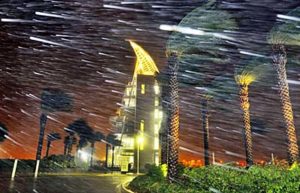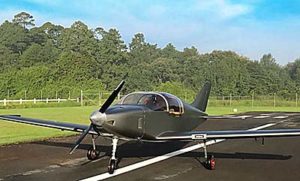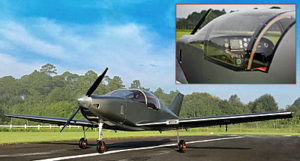
A few miles south of my home one finds Kennedy Space Center, where this fascinating photo was taken. photo courtesy of Wall Street Journal
First a personal tale and then something completely different…
In the last week, I encountered something brand new to me, although old as the ocean. I refer to Hurricane Matthew, which swept through my home area of Daytona Beach late last week. You haven’t seen anything new on this website for a few days because, well… I was a little busy. Along with everyone else in this area, we spent days preparing for a Category 4 storm (identified as packing wind speeds of 135-156 miles an hour, enough to tear buildings apart). Everything outside was brought indoors. Sandbags were loaded and positioned because a 15 foot storm surge was predicted along with torrential rains. Because my dwelling — at the Spruce Creek Fly-in, an airport community (7FL6) — sits only 22 feet above sea level, such a storm surge took on epic damage possibilities.
Fortunately, the winds capped at 91 mph at the nearby Daytona Beach airport (KDAB). The storm surge was much less than forecast and the rain was not as heavy as anticipated. We probably owe this to a “wobble” the storm path took that kept it further out at sea. Thank goodness, the eye of the storm did not wander toward land. I don’t want to think about that.
To return everything to its normal place and to clean up the mess of branches and debris the storm scattered around took more time, so nearly a week was lost to Matthew. Nonetheless, the overall damage was less than anticipated so I am thankful while remaining concerned for losses sustained by others.
Now for “something completely different” (as the old Monty Python troupe used to call a new skit topic).After translating some Mexican websites, I was able to glean a few facts about a new aircraft, a Light-Sport Aircraft according to developers, that is reportedly the first airplane in 50 years to be made completely in Mexico. I found it interesting that this new LSA-like aircraft arrives from a furniture company. Perhaps that’s less unusual when you know that the airplane is made of wood, “extracted from fir and birch planted exclusively for aeronautical use and certified by the FAA,” said the companies.
After three years of work the timber airplane, designed by Giovanni Angelucci and built in Mexico, is approaching being market ready. The somewhat spartan news was released without naming a functional website where interested persons could find more details. Even determining what the new aircraft is called was not clear but since this is a launch project, it’s probably too soon for any enterprising business person to rush into representing the airplane.
Although the news released referred to the new aircraft as a Light-Sport Aircraft, the speeds they announced are well outside the U.S. category, hence my use of the term “LSA-like.”

The new Mexican airplane is power by a very familiar engine, the 100 horsepower Rotax 912, which places it more securely in the LSA sector. Endurance was listed as six hours yielding a range of better than 800 nautical miles, suggesting a fuel supply of about 30 gallons. Empty weight was shown at 330 kilograms or about 725 pounds, again roughly typical for the LSA category. Ceiling was shown as 15,000 feet.
The developers noted, “[The airplane is an] artisanal manufacture by cabinet makers.” Such advanced wood-working skills were “applied to the design to ensure the efficiency and durability of the aircraft over time. Its use is sporting, recreational flying and can be used by flight schools and such work as territorial surveillance.” The new plane comes from an alliance of Horizontec and Pirwi.
The companies added, “[This] will be the first airplane manufactured in Mexico since last century… and will contribute to the reactivation of the Mexican airline industry, which since the ’50s did not produce full, but only aircraft parts.”
“The design was confirmed by the Aviation Cluster of Queretaro and the Aeronautical University in Querétaro (UNAQ), which for three years has harbored the project.” The new aircraft is priced at $180,000 and will be [built] on request in order to customize to the taste and needs of each client.
You can’t see the Mexican entry at the DeLand Showcase coming up in just three weeks (November 3-4-5), but you can see the Jabiru J-230-D and many more Light-Sport, light kit, and ultralight aircraft. More details at DeLand’s website.



Leave a Reply